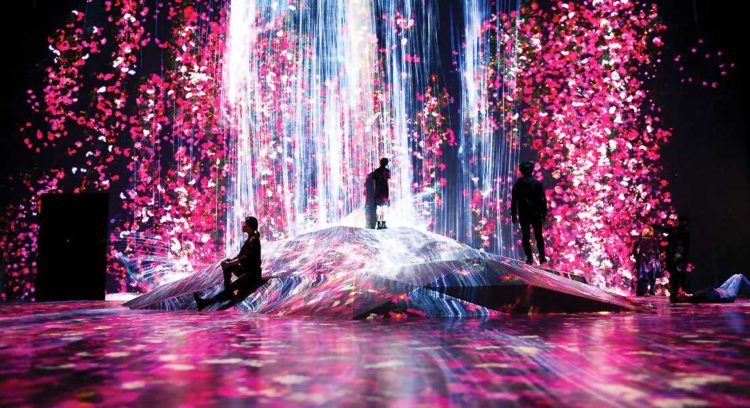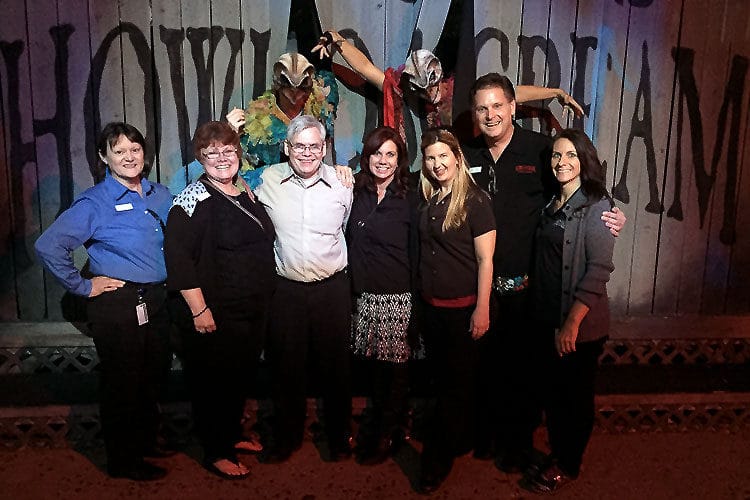Asian attractions dominate the 2019 TEA Thea Awards
The attractions industry is exploding in Asia. Mainland China expects to have 59 new theme parks by 2020 and quality is keeping pace. Proof of Asia’s quality development is in the 2019 TEA Thea Award recipients. 40% of the Theas (six out of 15) went to Asian recipients.
Seasonal attractions develop along with the attractions industry for several reasons: attractions host seasonal events to encourage repeat visits; attraction attendees are similar in demographics to seasonal attraction attendees; and only markets large enough to sustain attractions will sustain a thriving seasonal market. So, understanding the trajectory of Asian themed entertainment is critical for continued success in the seasonal attraction industry.
The Asian industry represents new opportunities for seasonal attraction experts because Halloween/Christmas are not native to Asia. Many Asian venues look to the North American region for design help. Examples include Ocean Park Hong Kong, Hong Kong Disneyland, and Universal Singapore. Quan Gan (founder of Gantom in California) started the first haunted attraction in Shanghai back in 2009. This article is a primer for you to understand the Asian market to capitalize on future opportunities in the region.
This article originally appears in InPark Magazine and is reprinted with permission.
The Asia Pacific Theme Park Industry
The Asian theme park industry is young and has developed on a fast track, in contrast to its more slowly evolving counterpart in the West. Theme parks in the West began as small, low-tech attractions (think Knott’s Berry Farm) that grew in technological complexity over time. In Asia, the pace has been faster and technology-focused from the outset.
Asia Pacific will account for 62% of the global growth in attendance for the theme and amusement park market over the next 5 years. IAAPA projects amusement-park spending in Asia Pacific to increase to $21.5 billion in 2022. For comparison, North America spending will expand to a projected $29.7 billion in 2022.
Asia Pacific: China and Japan
China has been the fastest-growing market (16.5% increase in 2017), accounting for 83% of the overall growth in attendance for the region. Attendance benefited in 2017 from an entire year of operation from Shanghai Disney Resort and Fantawild Oriental Heritage. China will remain the quickest growing Asia Pacific market for the next five years.

While the attractions market is expanding in China, Japan remains the largest market in the Asia Pacific region. Spending in Japan’s amusement-park market grew 2.4% to $6.7 billion in 2017. By 2022, IAAPA projects Japan’s spending to top $9.2 billion with China trailing just behind at $8.18 billion.
Attendance Drivers
The opening of new parks and attractions will drive attendance growth for the next five years in the Asia Pacific region. Two of the main trends at these parks will be attractions that use popular movie IP and higher ticket prices. In China, Disney-Pixar Toy Story Land at Shanghai Disney Resort and Shanghai Polar Ocean Park, a polar theme park, opened in 2018. Universal Parks and Resorts is increasing its investment in Universal Studios Beijing from $3.3 billion to $6.5 billion. Six Flags has plans for three parks in the Nanjing area—the first opening in 2021—and is planning 11 parks in China in the coming years.
The 2019 Asian Thea Awards Recipients
While the 2019 Asian Thea Award recipients ranged from an LED waterslide to a giant revolving theater, they share a set of common elements:
- Technological breakthroughs
- Every recipient relies on a leap in technology.
- The dissolving of medium boundaries
- While the Thea recipients share the same medium as Western counterparts (theme park, museum, water slide, auditorium, parade, and dark ride), each recipient alters the medium’s boundaries. What if a water slide rotated and was also a light show? What if exhibits in a museum moved to interact with each other? What if set changes disappear from a live performance? The Asia Pacific recipients dissolve the traditional boundaries of their mediums and challenge the industry to keep up. Guests come closer than ever before into the narrative, and it’s just the beginning.
- Multigeneration family entertainment offerings
- We design themed entertainment for families in the East as in the West. The manifestation differs in the West because of differing cultural norms. The family unit (including extended family) is essential in Asian culture, as opposed to the more independent shift in the West. Thus, the award recipients’ attractions design for the multigeneration visitor in mind.

Fantawild Oriental Heritage
Fantawild Oriental Heritage in Wuhu opened in April 2017. It’s the 22nd park developed and operated by Fantawild Holdings. Fantawild Oriental Heritage blends aspects of traditional Chinese culture with technology-driven attractions. The park has nine thematic areas, 12 major attractions, and a cultural heritage town. The attractions incorporate thousands of years of Chinese history, culture, and folktales enhanced by traditional architecture, classic food, and live entertainment. In-house animation and special effects units at Fantawild developed these attractions.
Fantawild Oriental Heritage received a TEA Thea Award for integrating “technology-based immersive experiences with the rich folklore and culture of China. It brings together an exceptional blend of live entertainment, large-scale shows, and engaging dark-ride experiences to deliver a unique and compelling family destination,” stated the TEA Thea Awards Committee.
Besides operating theme parks, Fantawild produces original animations, themed performances, and consumer products. Media companies using theme parks to enhance their IP distribution and merchandising sales isn’t new. However, Fantawild finds a niche in its dedication to integrated technology. Fantawild’s philosophy—“with Culture as its Core and Technology as its Support”—focuses “on creating stories with unique Chinese characteristics; Fantawild is committed to spreading Chinese culture across the globe.”
Technology is likewise at the heart of Fantawild’s mother corporation, Huaqiang Holding Group (established in 1979), whose portfolio shows a substantial investment in the field. Among its properties is Huaqiang Electronics World (Shenzhen), “the largest comprehensive trade and exhibition center for electronic components in China; it attracts over 200,000 visitors everyday, and has an annual trade volume more than 500 billion RMB.” A technology company turned theme park developer in Asia Pacific’s fastest-growing market will make for an exciting evolution in the industry!
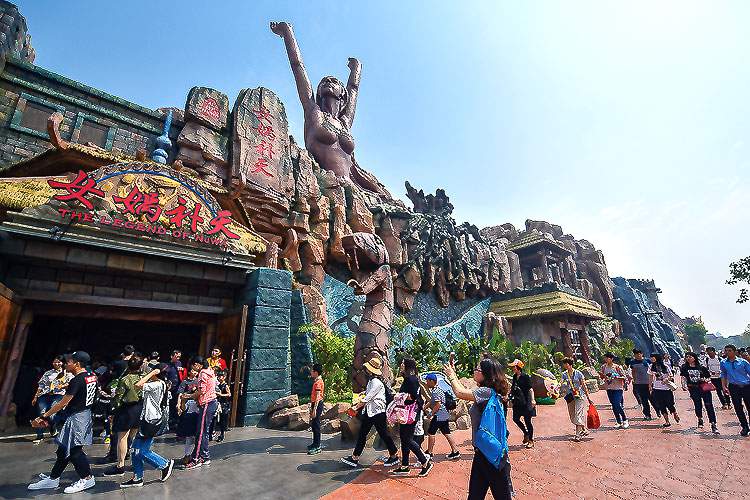
Legend of Camel Bells
Legend of Camel Bells is a live-action production that depicts the grandeur of legendary Chinese storytelling. The production brings the audience along with a group of traders who are traveling along the Silk Road from China to ancient Rome during the Tang Dynasty (618-907). Along the way, the travelers encounter extreme weather, life-threatening dangers, and fantastic sights, all presented in seven scenes with different sets. Xia Chunting, chairman of Huaxia Wenlv Group, produced the show.
In conventional live-action production, scenes play out on a single stage as the audience witnesses set changes. In Legend of Camel Bells, the auditorium revolves, bringing the audience to the next set. Set changes disappear; thus, the sets are more elaborate. “The six sets for the show (one for each story chapter) ring the audience platform. Each set is an elaborate, permanent installation with integrated technology systems, rigging, and effects. The rotating auditorium is capable of revolving 360 degrees, as well as back and forth, to bring the audience into position relative to the sets as the story unfolds,” summarized Judith Rubin in InPark Magazine’s issue 76 cover story.
The TEA Thea Awards Committee made this statement about Legend of Camel Bells: “Legend of Camel Bells wows the audience with stunning stage effects, massive props, extreme scenery, a huge cast, animal actors, a 15-meter-tall volcano and snow mountain, an 18-meter-high Buddha and a 20-meter-high by 40-meter-wide waterfall—all presented on the massive, oval-shaped stage, backed by a 4,000-square-meter LED screen. The adventure is continuous as the 3,000-person audience platform rotates seamlessly from scene-to-scene. This show represents the highest level of visual imagination and design, theatrical flair, showmanship, and execution.”
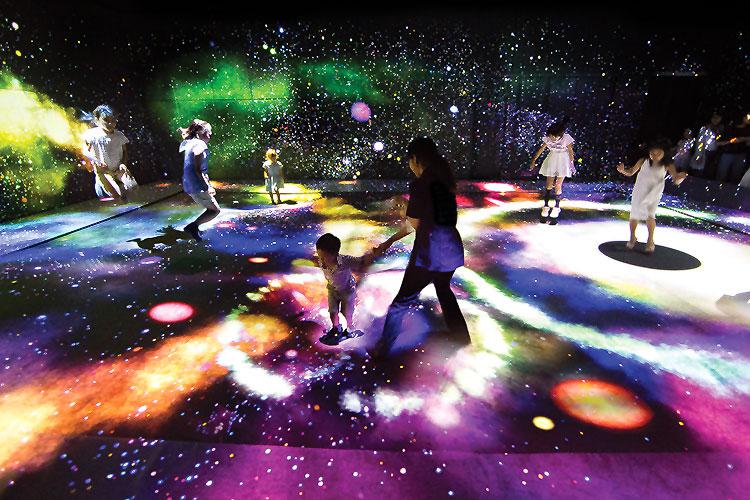
MORI Building Digital Art Museum—teamLab “Borderless”
While ‘immersive’ is a contested term in the industry, three elements continually surface— complete environments, agency, and consequence. Immersive experiences allow guests to make choices that alter their experience, all contained within a complete environment (or microcosm, if you prefer). With a few exceptions, museums are notoriously non-immersive. Guests walk through rooms and stare at fixed exhibits. However, what if the exhibits weren’t fixed? What if exhibits moved between rooms and responded in real time to what you do? What if there were no ‘rooms’ but the floor, ceiling, and walls merged into one endless canvas? TeamLab brought together architects, engineers, programmers, CG animators, mathematicians, musicians, and designers to create such an immersive museum in Tokyo.
After exhibitions in Singapore, London, Paris, and Shenzhen, teamLab collaborated with local urban landscape developer MORI Building Co. Ltd. to create a permanent attraction called MORI Building Digital Art Museum—teamLab Borderless. Borderless is a massive, three-dimensional experience that takes place in five zones within a 10,000-square-foot space. The artworks flow out of rooms, communicate with other works, influence, and sometimes intermingle with each other without boundaries.
“This simple yet innovative combination of analog interactive installations and advanced, projection-mapping visuals equals a world-class, non-linear entertainment experience that allows thousands of visitors daily to explore, wander, and discover at their own pace. The level of technical complexity (520 computers/470 video projectors/interactive sensors, etc.) and the overall quality of the experience makes ‘Borderless’ a new reference point and potentially a ‘game-changer’ in the industry,” stated the TEA Thea Awards Committee about the MORI Building Digital Art Museum—teamLab Borderless production.
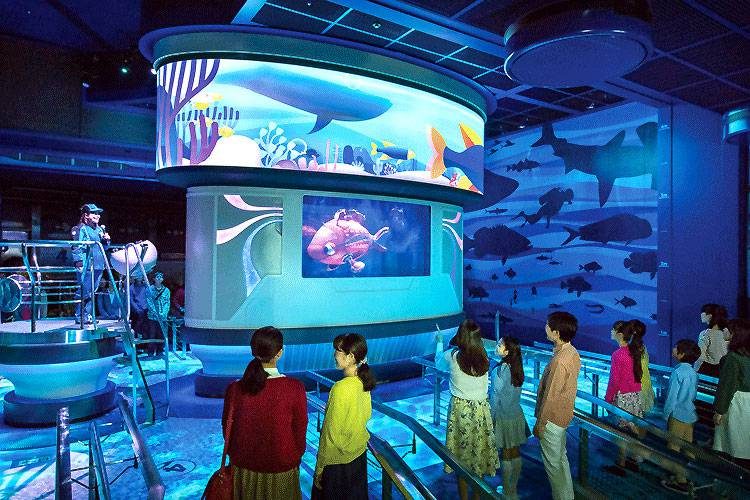
Nemo & Friends SeaRider
Rides are expensive. Theme parks must wait decades to receive the full ROI on rides, especially those with high theming. When a market (Asia Pacific) is technology-sensitive, themed rides get outdated rapidly. What’s the solution? Refurbish and repurpose. Proper execution is tricky, but Disney is on a roll (likely due to their experience with Western parks). Disney received two Theas in 2018 for attraction reimagining: Guardians of the Galaxy – Mission: BREAKOUT! and Frozen Ever After. 2019 sees Disney receiving another for SeaRider.
The Disney/Pixar films Finding Nemo and Finding Dory inspire the SeaRider simulator ride, which opened in 2017. Part of Tokyo DisneySea, SeaRider was repurposed from its predecessor, StormRider. SeaRider includes a new exterior theater façade, a new pre-show, and a real-time experience for each group of voyagers.
The storyline for SeaRider is this: At the Marine Life Institute in the heart of Port Discovery, scientists have created a substance called “Chidiminium” that can conduct electricity and shrink materials. This new material is used to safely shrink the SeaRider, a fish-shaped submarine in which guests ride. The SeaRider features artificial fish intelligence, which allows it to think like a real fish and operate without a pilot. Guests dive into the sea aboard this fish-submarine and meet marine life such as Nemo, Dory, and Marlin, who take passengers on a journey through the ocean where they encounter numerous characters from the two Finding Nemo films. Disney composes each voyage on the SeaRider vehicle in real time with more than 576 different video clips that create varying storylines for each 14-minute ride.
About Nemo & Friends SeaRider, Tokyo, the Awards Committee wrote, “The attraction is beautifully executed and subtly transformed. The immersion effect composed of video and motion is perfectly balanced, providing the guests with a feeling of riding in the water and plenty of surprises and action to entertain. The team found the perfect balance of elements to make this a charming and exciting ride for the whole family.”
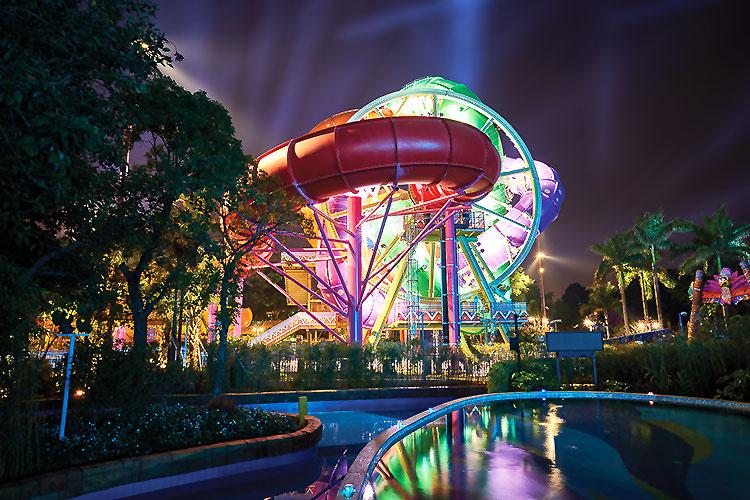
SlideWheel
The SlideWheel at Chimelong Water Park is the world’s first rotating water slide. Chimelong included SlideWheel, designed by Wiegand Mazeler, in the park’s April 2018 grand opening. The SlideWheel is a one-of-a-kind, 110-second experience comprising sliding, swinging, twisting, shaking, rotating, and zero gravity. Up to 480 passengers an hour can slide through on four-person rafts.
The German-made water slide doesn’t stop there – SlideWheel turns into a light show at night. The 24-meter-tall, rotating SlideWheel uses over 700 LED lights on the interior and exterior to create a stunning visual seen throughout the park. The light show capitalizes on the physical slide structure and eliminates the need for extra support rigging (always an eyesore). The lightweight LED lights (the norm now versus the massive, energy-sucking incandescent fixtures) make the feat possible. Thus, the attraction not only succeeds on novelty of experience but adds entertainment value to the evening offerings.
About the SlideWheel, the TEA Thea Committee wrote, “SlideWheel is a highly engineered and innovative achievement that provides guests both visual and physical sensations that are unique to the waterpark industry.”
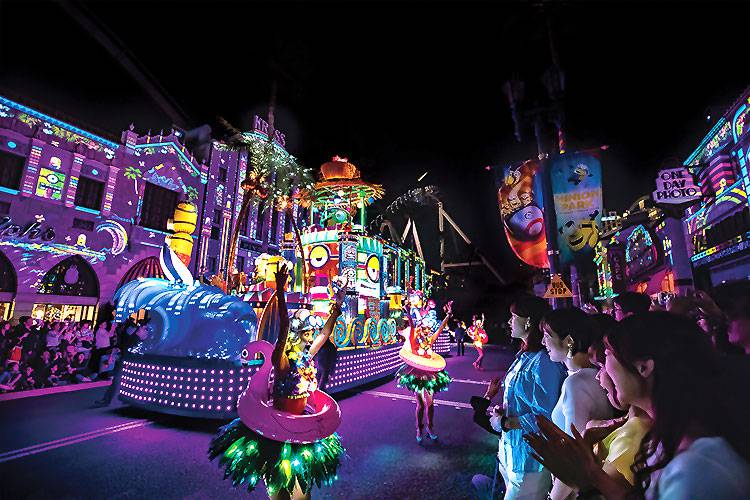
Universal Spectacle Night Parade – The Best of Hollywood
Parades are a theme park staple. The standard recipe is a character on a float repeating the same scene with dancers in between. In Universal’s new parade, each segment is an evolving narrative where characters impact the environment and exit the float.
The Universal Studios Night Parade—The Best of Hollywood, at Universal Studios Japan in Osaka, implements an innovative parade-control system that synchronizes onboard and off-board projection mapping with the progressive movement of parade units choreographed to a musical score. The massive, virtual, movie-based environments synchronize with puppeteered creatures and live performers to achieve a dazzling, multi-sensory experience for guests.
For example, a full-size Hogwarts Express rolls down a cloudy, projection-mapped street. The windows reveal students enjoying conversation before—a Dementor attack! Nearby students (dancers) cast spells that fend off the projected Dementors. Other environments include Transformers, Jurassic World, and Despicable Me.
“Universal Studios Japan has dramatically reinvented the stage on which their nightly pageant performs. The result really lets guests ‘live the movies,’” wrote the TEA Thea Awards Committee.
Key Takeaways:
- Mainland China expects to have 59 new theme parks by 2020, and quality is keeping pace.
- Seasonal attractions develop along with the attractions industry.
- The Asian industry represents new opportunities for seasonal attraction experts, because Halloween/Christmas are not native to Asia.
- The Asian theme park industry is young and has developed on a fast track, in contrast to its more slowly evolving counterpart in the West.
- IAAPA projects amusement park spending in Asia Pacific to increase to $21.5 billion in 2022. For comparison, North America spending will expand to a projected $29.7 billion in 2022.
- While the attractions market is expanding in China, Japan remains the largest market in the Asia Pacific region.
- Two of the main trends at these parks will be attractions that use popular movie IP and higher ticket prices.
- The 2019 Asian Thea Award recipients share a set of common elements:
- Technological breakthroughs
- The dissolving of medium boundaries
- Multigeneration family entertainment offerings
ABOUT THE AUTHOR
Philip Hernandez
Philip Hernandez is a freelance writer, speaker, producer, and marketer specializing in Seasonal Attractions.
In 2018, Philip became the CEO at Gantom Lighting & Controls, a manufacturer of the world’s smallest DMX LED lighting. Gantom is used in every major theme park worldwide to illuminate where other fixtures cannot.
Since 2014 Philip has published Seasonal Entertainment Source magazine (SES), a quarterly print publication for the seasonal attraction professional. SES ships to readers in over 18 countries.
Philip operates the Haunted Attraction Network (HAN), the largest global media entity for the haunted attraction industry. HAN includes written content, videos, a series of podcasts, and the Haunt Design Kit brand.
Philip produces the Leadership Symposium for Seasonal Attractions, a masterclass series for seasonal attraction professionals. Watch more here.
Philip co-hosts the ‘Marketing your Attraction’ podcast monthly. Listen here.
Contact Philip for projects here: [email protected]
